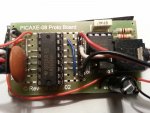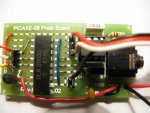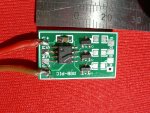jensmith25
Senior Member
I have a project I'm working on that requires a small PCB - ideally the size of the 08 proto board AXE021 or smaller but that can run 6 LEDs.
Ideally I would use the 14m Project board AXE117 which is slightly too big or an 08 board with a darlington driver but that doesn't seem to be available.
As the 08m2 pins are ok up to 20mA is it ok to run two LEDs at 8-10mA off one pin or is this too risky?
This may be way off but as an alternative is it possible to use the AXE023 motor driver board which can take higher current?
Thanks for any advice,
Jennifer,
Ideally I would use the 14m Project board AXE117 which is slightly too big or an 08 board with a darlington driver but that doesn't seem to be available.
As the 08m2 pins are ok up to 20mA is it ok to run two LEDs at 8-10mA off one pin or is this too risky?
This may be way off but as an alternative is it possible to use the AXE023 motor driver board which can take higher current?
Thanks for any advice,
Jennifer,



